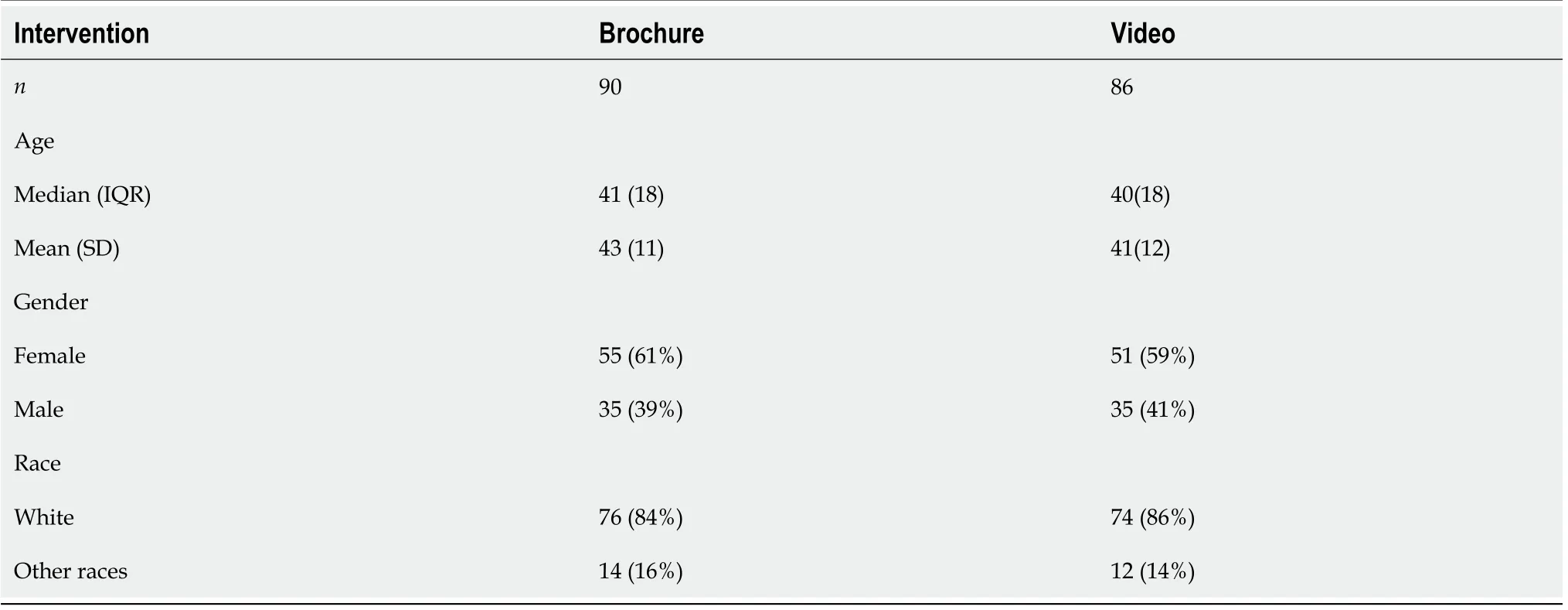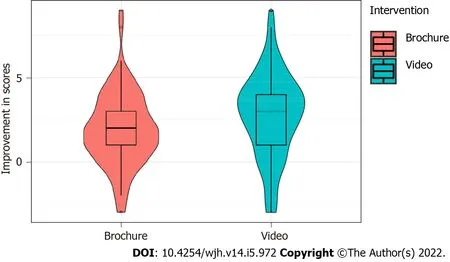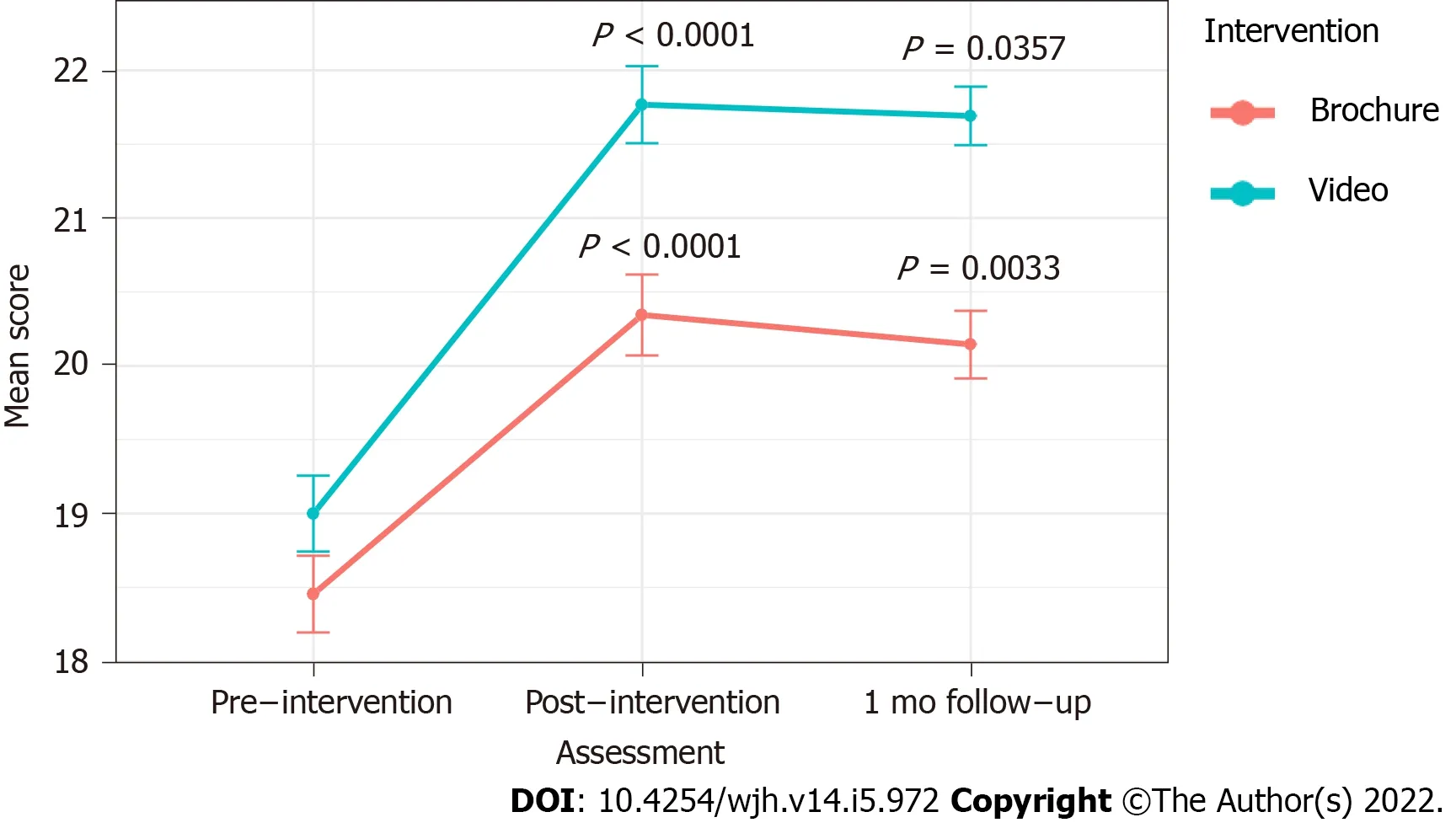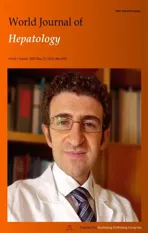lnnovations in education:A prospective study of storytelling narratives to enhance hepatitis C virus knowledge among substance users
2022-07-04AndrewTalalYuXinDingMarianthiMarkatou
Andrew H Talal,Yu-Xin Ding,Marianthi Markatou
Andrew H Talal,Department of Medicine,University at Buffalo,State University of New York,Buffalo,NY 14203,United States
Yu-Xin Ding,Marianthi Markatou,Department of Biostatistics,University at Buffalo,State University of New York,Buffalo,NY 14214,United States
Abstract BACKGROUND Even though substance users have the highest hepatitis C virus(HCV)burden,many lack knowledge about the infection.Lack of knowledge is an important obstacle to pursuing HCV care.Although printed materials are conventionally utilized to disseminate HCV-related knowledge,narrative story-telling videos may be an alternative.Data are extremely limited,however,in the ability of storytelling videos to increase HCV knowledge among substance users.In this study,we hypothesized that a story-telling narrative video would increase substance user’s immediate and 1-month HCV-related knowledge compared to a printed format.AIM To assess immediate and 1-month HCV-related knowledge retention among substance users comparing education delivered viaa storytelling narrative video compared to a printed format.METHODS We conducted a prospective matched,case-control study among substance users actively prescribed buprenorphine enrolled from two sites.The intervention site received the video and the control site,the brochure.Participants(n= 176)were matched on age,gender,and race.We obtained extensive patient and stakeholder input on the video’s design,validated the video’s content,and developed a recruitment plan to guide participant enrollment.Knowledge was assessed by administration of a 25-item instrument immediately before,immediately after,or one month after the intervention.Data were analyzed using nonparametric and generalized linear mixed-effects models.RESULTS We recruited a total of 176 substance users,90 and 86 individuals,from each site,respectively.One-month follow up occurred in 92% and 94% of enrollees in the control and intervention groups,respectively.In comparison with the pre-intervention scores,immediate knowledge recall increased significantly for both the intervention(P <0.0001)and control(P <0.0001)groups.Multivariate modeling revealed a significant improvement in HCV-related knowledge and retention(P= 0.033)among participants who viewed the storytelling video.CONCLUSION Storytelling narratives emphasizing HCV education appear to be an effective method to increase HCV-related knowledge among substance users.They should become an educational cornerstone to promote HCV management among this population.
Key Words: Hepatitis C virus education;Hepatitis C Virus;Hepatitis C virus knowledge;Persons with opioid use disorder;Decision-making in healthcare
lNTRODUCTlON
Hepatitis C virus(HCV)is an extremely common chronic blood-borne virus pathogen and is principally transmitted through injection drug use[1].HCV is a leading cause of morbidity and mortality among persons with opioid use disorder(PWOUD)reaching as high as 80% with an annual incidence ranging from 16% to 42%[2,3].Untreated HCV can progress to cirrhosis,end-stage liver disease and hepatocellular carcinoma.Recently,direct acting antivirals(DAAs)have revolutionized HCV treatment.DAAs are all oral medications,administered for 2 to 3 mo,with nearly universal efficacy and minimal side effects[4].In fact,recent data have documented the importance of simultaneous treatment of opioid use disorder and HCV;treatment for both entities results in improved treatment adherence and a reduction in substance use[5,6].Given the importance and burden of HCV,the US Preventative Services Task Force recently revised HCV screening recommendations[7].Currently,all individuals aged 18 to 79 years should undergo a one-time HCV antibody test with more frequent assessments among high-risk individuals,such as PWOUD.In addition,HCV elimination by 2030 has been promulgated in the United States and globally[8,9].To achieve HCV elimination objectives,however,we need to address HCV knowledge gaps among PWOUD.Only fifty percent of HCV-infected PWOUD know their infection status,and many underestimate the urgent need for HCV treatment[10,11].Furthermore,substance users have recently been shown to have low to moderate health literacy levels[12-14],and health literacy is an extremely important predictor of health status[15].Thus,interventions to increase HCV-related knowledge targeted to PWOUD are required to achieve HCV elimination objectives[16].
Lack of consideration of health literacy status often complicates patient-provider communication especially among low health literacy populations.In terms of written material,a typical method of health knowledge dissemination,readability at an appropriate grade level is an important consideration.One study found that internet-derived liver disease information is written at a higher readability score than is recommended,an important potential source of misinformation among liver disease patients[17].In the area of HCV,several studies,which largely utilized in-person delivery of didactic sessions,have illustrated that educational interventions can improve HCV knowledge[18-22],screening[23,24],and linkage-to-care[25,26].These methods,however,can be burdensome in terms of cost,resources,and time requirements.Alternatively,computerized health platforms appear to facilitate health education dissemination ubiquitously and at a reduced cost compared to in-person lectures[27-30].While a few studies have assessed their educational value,these platforms largely disseminate facts or schematics about HCV or liver diseases using an instructional or didactic framework.While informative,these knowledge dissemination methods may not resonate with substance users.
Narrative videos,defined as “first-person stories about experiences with illness and its personal consequences”,have been shown to be more persuasive at behavioral change than written narratives or didactic lectures[31,32].Although data are limited,narratives that address healthcare issues may be a particularly effective method to increase knowledge among PWOUD.A systematic review concluded that videos detailing story-based messages were more persuasive than non-narrative videos[32].To improve HCV-related knowledge dissemination to substance users,we sought to develop and to validate an educational intervention targeted to PWOUD utilizing narratives presented in a video format.Virtual communication strategies,such as videos,are easily conductive to storytelling and can employ an expanded repertoire of communication styles in comparison with printed material.As storytelling is a particularly effective pedagogical method amongst PWOUD,our objective was to assess whether a video would improve PWOUD’s immediate information recall and one-month knowledge retention compared with a written brochure.
MATERlALS AND METHODS
Study design
We conducted a prospective case-control study to assess immediate and longer-term knowledge retention comparing two different educational delivery methods.The control arm received an HCV educational brochure,and in the intervention arm,participants viewed a twelve-minute educational video,which contained the same information as was included in the brochure.Participants in each arm also completed the same knowledge assessments at the same time points: prior to reading the brochure or viewing the video,immediately following the interventions(i.e.,brochure or video),and within 30 +/- 14 d of the initial time point.
Participants were recruited according to a recruitment plan(see below)between January and October,2020 from community health organizations that provide treatment services,specifically buprenorphine,for opioid use disorder.Each site is under the auspices of New York State Office of Addiction Services and Supports(OASAS)and has adopted a harm reduction approach,which refers to policies and programs designed to reduce drug-use associated harm;the goal is harm prevention from drug use rather than prevention of drug use itself[33,34].
Participant inclusion criteria included individuals at least 18 years old,who were currently prescribed buprenorphine,and who spoke English as their primary language.
Patient consent statement
The study was approved by the University at Buffalo and the Catholic Health Service Institutional Review Boards,and all patients provided informed consent prior to participating in any study related activities.
Video,brochure,and knowledge assessments
Brochure:As the American Liver Foundation is a principal source for patient-oriented printed materials and handouts on a variety of liver diseases,we utilized their instructional brochure for information about HCV(Supplementary material).
Video:Patients provided the initial concept of a video and enabled us to identify important HCVrelated knowledge gaps in the areas of diagnosis,pathogenesis,transmission,screening,treatment,and long-term infection consequences.We subsequently reviewed and expanded the identified topics with opioid treatment program staff.Staff also described knowledge dissemination methods for PWOUD,such as emphasizing that visuals are extremely important and that human stories are “priceless”,consistent with prior literature[35].The narrative within the video contains a storyline with a beginning,middle and an end where the storyline conflict is brought to conclusion[36].Based upon acquired feedback,we incorporated visualization strategies into the video,such as emphasizing main points in words or captions strategically situated within the image frame,to underscore the important pedagogical value.
We next reviewed the brochure to ensure that the same information would be presented in both educational formats and subsequently engaged a professional screenwriter to develop the video script.Multiple iterations of the script were reviewed to ensure the accuracy of the educational information.After filming and editing,a draft version of the video was reviewed and finalized by the study team and content validity was assessed as described below.The final video is available at: https://drive.google.com/file/d/1mrJbXpRl7YrqbhoPH3sUphOTz2TNgc0e/view?usp=sharing.
Knowledge assessment design and assessment of content validity:Details related to the design of the knowledge assessment and the assessment of its content validity are described in the Supplementary material.
Recruitment plan development
We matched participants recruited from each site on age,gender,and race to control for potentially unmeasured confounding factors.We initially evaluated the demographics of all individuals from both sites.After considering the inclusion criteria and those with complete demographic information,the intervention site had 1647 potential participants and the control site had 526 potential participants.The two sites were randomly assigned to either the intervention or the control.
We next used gender,age and race to perform 1:1 exact matching of individuals from the two sites utilizing the “Match” function(R package,version 3.5.3)[37].Given the paucity of nonwhite individuals,potential participants were categorized into two groups: white and other races.Age was also classified into two groups: age ≤ 39 or > 39 years.The algorithm identified 7928 exactly matched pairs in which 508 pairs were unique individuals from the control site.According to the distribution of matched individuals,each site was requested to recruit 90 participants according to the proportion in each category(See Supplementary material for sample size calculation and Supplementary Table 3 for the recruitment plan).
Recruitment
Site staff initially identified potentially eligible participants on the clinical schedule and then assessed potential participant’s interest in study participation.If interest was affirmed,research staff next obtained informed consent.Afterwards,we verified participant demographics,and they completed the pre-test assessment.Participants then read the brochure or watched the video,and they promptly completed the knowledge assessment a second time(i.e.,post-test assessment).Thirty days afterwards,we requested that participants complete the third knowledge assessment(1 mo post-test assessment).We compensated participants $40 for completion of all assessments.After the COVID-19 pandemic,we recruited approximately 20% of participantsviatelephone.
Statistical analysis
We performed complete-case analysis since less than 5% of the data were missing.We initially calculated the participants’ response scores obtained on each knowledge assessment;each correctly answered item garnered one credit.The improvement in knowledge attributable to the intervention was defined as the difference in scores between post- and pre- educational intervention assessments.We used the Wilcoxon signed-rank test to compare each participants’ pre- and post-educational intervention scores[38].We applied the Wilcoxon rank sum test to compare the improvements in participants’ scores between post- and pre-educational intervention tests between the two sites.All significance tests were performed by using R version 3.5.3[37].
Our outcome variable is the number of correct answers provided by each participant.To incorporate the time effect into our analysis and since the outcome data are counts,we used a generalized linear mixed-effects model.The fixed effects include gender,race,educational intervention,timepoint(posteducation and one-month follow-up)and clinic by visit interaction with all variables measured on a categorical scale,and we incorporated age in the model.Race was categorized into two levels(whitevsother races),considering the small sample size of the nonwhite population.We modeled the preeducation test scores through model inclusion as the baseline(BL)value,XBL,i,associated with the ithstudy participant to adjust for differences in participants’ educational levels and other potential unmeasured confounders that might have affected baseline scores.The random effects corresponded to unknown subject effects and was captured the within-subject variability.The outcome data were assumed to be Poisson distributed and the ln(log link with base e)was used in the generalized linear mixed-effects model(SAS Version 9.4,SAS Corporation,Cary,NC).
RESULTS
Demographic characteristics
We recruited 90 and 86 participants from the control and intervention sites,respectively,according to recruitment plan specifications.Participant demographics are illustrated in Table 1.
Participant questionnaire completion
We requested that each participant complete a knowledge assessment immediately preceding and upon conclusion of the educational intervention.They also completed the same assessment one-month after the intervention to investigate longer-term knowledge retention.The proposed and actual numbers of study participants who were recruited and their response rates,as assessed by completion of the pre-,post-,and one-month follow up assessments,are illustrated(Supplementary Table 3).

Table 1 Demographic characteristics of study participants
In terms of response rates,all 90 participants in the control and 86 participants in the intervention arms completed both the pre- and post-educational intervention assessments.In terms of one-month follow-up response rates,7 control and 5 intervention participants did not complete the assessment.
Descriptive and graphical analysis
Pre- and post-educational intervention results:For participants who observed the video,posteducational intervention scores improved significantly in comparison with pre-intervention scores(the value of the Wilcoxon signed-rank test is V = 2848.5,P <0.0001).For control participants,significant differences between the post- and pre-intervention scores are also observed(V = 2816,P <0.0001).
Improvement in educational intervention results:We also illustrate the improvements in the scores comparing the post- and pre-intervention assessments graphically(Figure 1).The significant improvement(W = 4817 andP= 0.0047)in test scores comparing each intervention is shown[39].The improvement in test scores was greater among participants in the intervention arm as compared to the control arm.
One-month education retention results:The raw mean of participants’ scores on pre- and posteducational intervention as well as on the one-month follow up assessments are illustrated(Figure 2).We observed substantial improvements from the pre-intervention to the post-intervention assessments in both clinics accompanied by a slight reduction in the scores obtained on the one-month follow-up assessments.The intervention site was observed to have a relatively higher improvement in the postintervention assessment and improved knowledge retention on the one-month follow-up assessment.

Figure 1 The distribution of improvement in scores calculated as the pre-intervention subtracted from the post-intervention for both interventions are illustrated in the violin plot wrapping a boxplot.The box extends from the 25th to the 75th percentile with lines extending outward depicting the smallest value within 1.5 times the interquartile range(IQR)below the 25th percentile and largest value within 1.5 times the IQR above the 75th percentile.The dark line in the middle of the box illustrates the median values.Peach indicates the control site(brochure)and blue(video)the intervention site.The violin displays the density plot of the values,where the width indicates the frequency.

Figure 2 lllustrated are mean scores for the assessments obtained pre- and post- as well as after one month after the video(blue)and brochure(red/peach)educational interventions.
Impact of COVID-19
Due to COVID-19-related restrictions,some of the intervention site participants were recruitedviaphone.Data indicate that pre-education scores are approximately similar comparing participants recruited in-person with thoseviaphone(Table 2).
Multivariate modeling results
We utilized a generalized mixed-effects model to model the data.Table 3 shows the type III tests results for fixed effects,which utilizes the exact F tests.Modeling results revealed that the type of educational intervention,specifically the video,had a significant effect on the improvement in HCV-related knowledge and retention(P= 0.0326)as compared to the brochure(Table 3).The age,gender,race,and the interaction term of the intervention and time point are not significant.The overall time point effect is significant(P= 0.0004),and within each clinic,the least square mean differences between one-month follow up and post-education test scores are -0.0634(P= 0.0357)and-0.0908(P= 0.0033)for the video and brochure,respectively,which indicates a 0.0634 decrease in test score on the one-month follow-up compared to the post-intervention assessment for the video group and 0.0908 decrease in the brochure group.The baseline score,i.e.,the number of correct responses prior to any educational intervention,has a significant impact on the post-intervention and one-month follow-up test scores withP <0.0001.We refer to this variable as the baseline score;its inclusion in the model adjusts for any pre-existing knowledge differences that might exist between clinics.

Table 2 Descriptive statistics associated with pre-education scores of individuals recruited on site and those recruited via phone

Table 3 Results of type lll tests of fixed effects
DlSCUSSlON
In this study,we developed and validated an HCV educational narrative video targeted to PWOUD.Each narrative emphasizes HCV-related knowledge,and we utilized technological enhancements to underscore important points.Utilizing a case-control design,we subsequently enrolled PWOUD on buprenorphine from two separate sites,one received the intervention and the other was a control site.Although both the video and the printed formats increased immediate recall and retention of HCVrelated knowledge,gains were significantly greater amongst the participants who viewed the video.
Substance users have a method for information spread amongst themselves,referred to as the “peer pipeline”,that compromised our ability to randomize at the patient level[40,41].To minimize bias between the two sites,we matched participants on demographic factors including age,gender,and race.Several attributes between the sites were similar,including staffing ratios,treatment philosophy,and therapeutic approaches,since both sites are under the direction of the same state agency(OASAS),which regulates and funds medications for opioid use disorder(MOUD)dispensed in New York State.
Education about HCV and the benefits of DAAs is essential to promote PWOUD pursuit of HCV treatment and is required to achieve HCV elimination objectives[8,9].Low to moderate health literacy in PWOUD and misinformation concerning basic facets of liver disease among many liver disease patients are important considerations in the design of educational interventions[12-14,42].While several prior studies have shown knowledge increases after HCV education,these studies enrolled different populations;some recruited hospital-based clinic patients while others recruited PWOUD[2,20,22,25,28].In a study conducted in PWOUD,no differences were identified in viral hepatitis-related knowledge between those undergoing a motivational interviewing style compared with standard counseling[20].Another study that reported low health literacy among PWOUD illustrated that personalized educational communication techniques result in increased knowledge[13].
Addressing HCV-related knowledge gaps requires innovative and targeted educational approaches.Storytelling narrative videos are a potential alternative to conventional in- person instructional lectures,although the latter has been evaluated in most HCV-related published work to date[27-30,43].One study used an I-pad platform to deliver educational instruction about HCV[30].Another study developed a didactic video about liver disease,and a third developed a short didactic video message designed to persuade PWOUD to pursue HCV surveillance[27,28].Additionally,Hochstatteret al.identified no differences in HCV testing uptake between intervention and control participants who utilized HCV-related educational content and functionality added to an m-health substance use disorder relapse prevention platform[29,43].mHealth systems developed to date designed to educate PWOUD about HCV appear to largely utilize a didactic approach complemented by linkage to community and government-based resources as opposed to narrative stories.
Multiple,as opposed to single,interventions have shown promise to improve health information comprehension by low literacy populations[44,45].Multimodal presentations,combined with storytelling narratives,allow for participant transportation into the narrative,defined as “the audience’s immersion in the imagined world”[36,46].The degree of the viewer’s emotional engagement with the narrative and the identification with the protagonist are important determinants of narrative’s persuasiveness for behavioral modification[47,48].Storytelling is used extensively to promote persuasiveness in healthcare[31,49,50],and video narratives have been shown to be more persuasive at health promotion than written narratives or instructional or didactic videos[32,51].Future investigation should evaluate whether different educational modalities will lead to improvements in PWOUD pursuit of HCV management.
Increasing PWOUD pursuit of HCV diagnosis and treatment can accrue significant benefits.Besides improvements in patient-reported outcomes,such as fatigue[52],an HCV cure decreases the risk of progression to cirrhosis and hepatocellular carcinoma[53].Furthermore,as alcohol intake has been shown to be an independent predictor of hepatic cirrhosis and mortality in HCV-infected individuals[54],alcohol cessation education is required for all HCV-infected individuals.
Extensive stakeholder input on the intervention design,the comparison group,the construct validation,and study design are investigative strengths.Additionally,we minimized potential bias by conducting the study in geographically separated sites and through matching participants on available demographics.We were limited by the inability to conduct a randomized trial given the research infrastructure present,the available resources,and the existence of the peer pipeline.We were,unfortunately,unable to collect information on participant’s education levels or on their substance use treatment course.To address these limitations,we included the baseline questionnaire responses as a dependent variable in the multivariate modeling.The inclusion of the pre-education test score controls for differences,for example,in education levels between the two sites.
HCV-related education is critical to promote PWOUD screening and linkage-to-care.PWOUD have the highest HCV prevalence and incidence,and highly-effective DAAs decrease HCV-associated morbidity and mortality[4].HCV treatment has also been shown to diminish or stabilize substance use,to improve retention in OUD treatment and to increase medication adherence[6,55].MOUD also reduces risk of HCV reinfection[56].To maximize the effectiveness of HCV educational interventions targeted to PWOUD,future investigation should evaluate knowledge dissemination and engagement among PWOUD comparing educational formats(i.e.,storytelling narratives vs.instructional/didactic formats)that incorporate multimodal technologies.
CONCLUSlON
Education improves HCV-related knowledge among PWOUD.Storytelling narratives significantly improve knowledge retention compared to written instructional brochures.They should become a cornerstone to promote HCV knowledge among PWOUD.
ARTlCLE HlGHLlGHTS
Research background
Despite high hepatitis C virus(HCV)incidence and prevalence,many substance users lack basic knowledge about HCV infection and its consequences.
Research motivation
HCV education targeted to persons with opioid use disorder(PWOUD)has largely utilized conventional written approaches through brochures and pamphlets.Innovative approaches,such as storytelling narrative videos,may be more appealing resulting in increased knowledge ascertainment and retention.Data are limited though on the ability of narrative videos to increase knowledge among substance users.
Research objectives
To assess immediate and 1 mo HCV knowledge recall and retention among substance users comparing education delivered via a storytelling narrative video to a written brochure.
Research methods
PWOUD on medication for opioid use disorder were prospectively enrolled from two sites,one site reviewed the written brochure and the other site viewed the video.Participants(n= 176),matched on age,race,and gender,completed the same knowledge assessments immediately prior to and upon completion of reading the brochure or watching the video.The same assessment was completed one month later to evaluate longer-term knowledge retention.We utilized generalized linear mixed-effects models to analyze the data.
Research results
We observed that both interventions significantly increased immediate and longer-term HCV-related knowledge.Multivariate modeling revealed significant improvements in HCV-related knowledge and retention(P= 0.033)among participants who viewed the storytelling narrative video.
Research conclusions
Storytelling narrative videos appear to be an effective strategy to increase HCV-related knowledge among PWOUD.Whether videos are an effective method to change behavior requires further investigation.
Research perspectives
Given their ability to include multimodal techniques and their ease of distribution,storytelling narrative videos may do well as an educational cornerstone to disseminate HCV-related knowledge to vulnerable populations,such as PWOUD,as well as to the general public.
ACKNOWLEDGEMENTS
We acknowledge the contributions of the administrative,counseling,and clinical staff at University of Rochester Strong Recovery Chemical Dependency for input on the educational topics of interest.We also acknowledge the staff at Catholic Health Services St.Vincent Health Center(Paul Updike MD,Judith Galante,RN,and Martha Gloss)and at Best-Self Behavioral Health(Stacie Capozzi,June Cline,and Amanda Arnone)for their assistance with patient recruitment and data collection.We also acknowledge Justin Bondi,Dr.Joe Huntz,James Huntz,and Dr.Mohammed Tahir for their assistance with designing and production of the instructional video.We also acknowledge Darlene Meyer and Cliff Minter,MPH for assistance with data collection,Joshua Osmanski for assistance with manuscript drafting,and Professor Melanie Green for helpful discussions.
FOOTNOTES
Author contributions:Talal AH conceived of the study,obtained funding,supervised data collection,wrote and revised the manuscript;Markatou M obtained funding,designed the study and supervised the analysis,wrote and revised the manuscript;Ding Y designed the study and performed the analysis,wrote and revised the manuscript;all authors have read and approve the final manuscript.
Supported bythe Investigator-Initiated Grant from Merck Inc,No.MISP# 57252;the Troup Fund of the Kaleida Health Foundation;and the Patient-Centered Outcomes Research Institute Award,IHS-1507-31640.
lnstitutional review board statement:The study was reviewed and approved by the University at Buffalo(Approval No.00002677).
Clinical trial registration statement:ClinTrials.gov Registration No.NCT04204447.Date of initial posting: December 19,2019.
lnformed consent statement:All study participants,or their legal guardian,provided informed written consent prior to study enrollment.
Conflict-of-interest statement:None of the other authors have any potential conflicts.
Data sharing statement:Data are available from the corresponding author at ahtalal@buffalo.edu upon reasonable request.
STROΒE statement:The manuscript has been prepared and revised according to the STROBE Statement.
Open-Access:This article is an open-access article that was selected by an in-house editor and fully peer-reviewed by external reviewers.It is distributed in accordance with the Creative Commons Attribution NonCommercial(CC BYNC 4.0)license,which permits others to distribute,remix,adapt,build upon this work non-commercially,and license their derivative works on different terms,provided the original work is properly cited and the use is noncommercial.See: https://creativecommons.org/Licenses/by-nc/4.0/
Country/Territory of origin:United States
ORClD number:Andrew H Talal 0000-0002-5565-7515;Yu-Xin Ding 0000-0002-1359-1247;Marianthi Markatou 0000-0002-1453-8229.
S-Editor:Wang LL
L-Editor:A
P-Editor:Wang LL
杂志排行
World Journal of Hepatology的其它文章
- Role of hepatitis Β virus in development of hepatocellular carcinoma:Focus on covalently closed circular DNA
- Emerging curative-intent minimally-invasive therapies for hepatocellular carcinoma
- Saving time and effort: Βest practice for adapting existing patientreported outcome measures in hepatology
- Loco-regional treatment of hepatocellular carcinoma:Role of contrast-enhanced ultrasonography
- Βenign focal liver lesions:The role of magnetic resonance imaging
- Pediatric acute viral hepatitis with atypical variants:Clinical dilemmas and natural history
